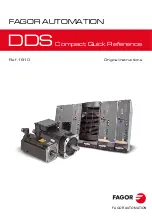
IMD 100 Integration manual 4189360015 Rev. G
Parameter description
Page 196 of 243
13.
Parameter description
This section describes the parameters and CANopen objects that can be used in the IMD. Internal
parameters are not included in this description since they have no value for the user. Where bit
mapping is relevant, it is described separately in section
. The full parameter list can
The parameters are identified by their name. Each parameter is mapped to a specific memory registry
address (Reg. ID). The same number as the address is also used as a CANopen object. For example,
Motor_Nom_V parameter that has a registry address 0x06, has a CANopen object ID: 2006.
13.1
Parameter types
Parameters are used for different purposes depending on their types. Some parameters are used
instead of constants in the SW, some parameters are used to invoke an action, some are for
configuration purposes and so on. The purpose of a parameter can be determined by its type. The
following table describes the different parameter types:
Table 31
Parameter types
Type
Typical
access
rights
Description
Configuration Read /
write
Parameters used for static configuration of the system. These
parameters are typically only configured once before commissioning.
Example of a configuration parameter is Maximum peak current
(0xC4).
Status
Read
only
Parameters used for information about different states and other
information about the current state of the IMD. Typical example of a
state parameter is Logic in block, used to determine the state of the
digital inputs (0x9B).
Protected
Read
only
These parameters are used for values that needs to be configured by
the manufacturer, but may not be changed by the users. Even though
the seemingly access rights for these parameters are Read/write, it is
not possible to write to these parameters. Example of a protected
parameter is the Device design current (0xC6).
Set-point
Read /
write
Parameters that are typically used by the application SW. They would
usually be accessed through CAN/CANopen, but they can also be
used from the IMD Manager. It is not necessary to invoke an action
after a change. Action will be taken automatically by the IMD. An
example of a special parameter is a position destination (0x6E).
Special
Read /
write
Parameters that are typically used by the application SW. They would
usually be accessed through CAN/CANopen, but they can also be
used from the IMD Manager. It is not necessary to invoke an action
after a change. Action will be taken automatically by the IMD. An
example of a special parameter is a Device enable (0x51).
Function
Read /
write
Parameters that invoke and action of the IMD. Typically, it is the write
operation to these registers that invokes a specific action. In two
functions (EEPROM operations, 0x83 and 0x84) the value of the write
operation, defines which configuration to load/save. An example of a
function parameter is Cancel Errors (0x8E).
















































